![]()
Associate’s degrees offer the fastest and most cost-effective option in degrees. Maybe you want to enter the workforce with a degree under your belt in just two years. Maybe you don’t want to shoulder the heavy financial investment that a bachelor’s degree requires. Or maybe you’d like to earn an associate’s degree at a small and affordable school, then transfer to a large, well-known school to finish up your bachelor’s. These common scenarios drive large number of students to seek out associate’s degrees.
Associate’s degrees have only been around in America since 1898, but have quickly evolved into a popular choice. In fact, according the the Census Bureau, a full 6% of American’s hold an associate’s degree as their highest level of education. That’s as many as hold a master’s degree! This figure doesn’t tell the whole story, however- of the 24% of American’s who hold a bachelor’s degree or higher, many started by earning their associates degree.
What’s the appeal? Associate’s degrees are attainable. They traditionally take just two years to complete, and can be affordably earned at community colleges, vocational schools, and even online. Associate’s programs are also frequently designed to meet the needs of busy working adults, who want a convenient and cost-effective way to earn their degrees.
For those who attain their associate’s degree, the rewards are real. Jobs requiring associate’s degrees paid an average salary of $58,240 in 2013 according the most recent survey by the Bureau of Labor Statistics. Top-paying jobs with an associate’s degree can earn significantly more; construction managers, for instance, make $83,860 per year on average, and radiation therapists earn $74,980. And the benefits don’t stop with higher earning. Study after study shows that gaining a college education leads to higher self-reported levels of health, happiness, and civic engagement. College grads are also more likely to own a home, belong to a labor union, and to contribute to a 401(k). An associate’s degree is an accessible degree level that will allow graduates to reap this wide range of benefits.
What Is an Associate’s Degree?
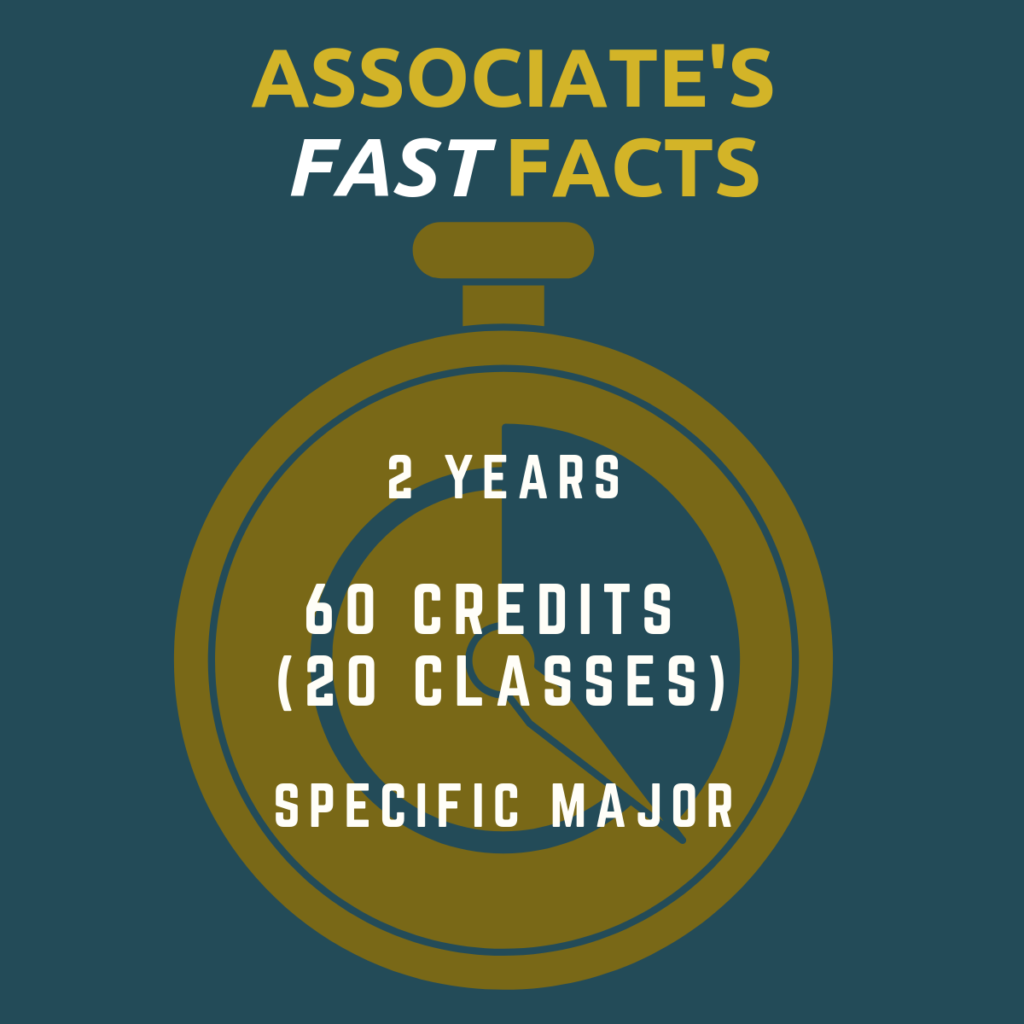
An associate’s degree is an undergraduate college degree that traditionally takes two years to complete. Associate’s degree programs are open to students with a GED or high school diploma. To graduate, you’ll need to complete 60 college credits, which is usually equal to 20 classes. Like bachelor’s degrees, associate’s degrees are specific to a major, a particular field of study such as nursing, design, or business administration.
Associate’s degrees can have an occupational focus or a transfer focus. Occupationally focused degrees are designed for those who want to launch a career without spending a lot of time and money on their degree. They are set up to provide training in the skills needed for a specific career, so that graduates can land an entry-level job in their field of choice. Those who want to eventually earn a bachelor’s degree usually go for a program with a transfer focus. These associate’s degrees may have workplace value on their own, but are specifically set up so that their class credits will count as the first two years of a four-year program. Graduates who have an associate’s degree from a program with a transfer focus (often earned at a community college) can then go on to complete two more years of school at a four-year college or university and walk away with a bachelor’s degree. With a bachelor’s, they can then potentially enter the workforce with a higher starting salary and job title.
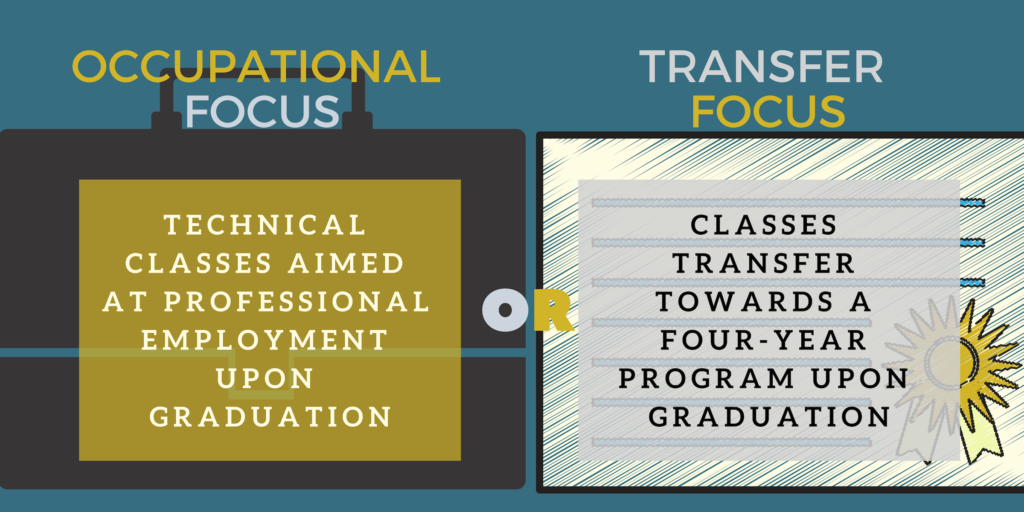
Students who plan to go on to earn a bachelor’s degree usually choose a major for their associate’s degree that allows them to meet many of the humanities requirements (such as composition, literature, and sociology) for a typical bachelor’s program. This allows them to focus on the courses for their bachelor’s major in their final two years of undergraduate classes. Students who take this path typically choose associate’s degree majors like Liberal Arts and General Studies. These are some of the most popular majors at the associate’s degree level. Other popular majors include Registered Nursing, Business, Criminal Justice, and other majors that are specific to well-paying, in-demand jobs.
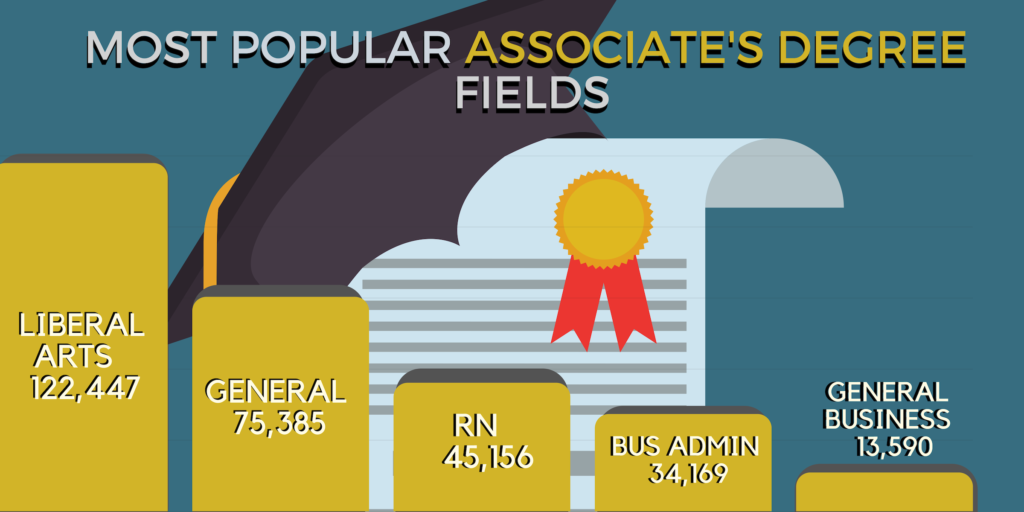
Associate’s Degree Types
Just as there are many different majors, there are also different types of associate’s degrees spending on your area of focus. The most common types of associate’s degrees are Associate of Arts (A.A.), Associate of Science (A.S.), and Associate of Applied Science (A.A.S.).
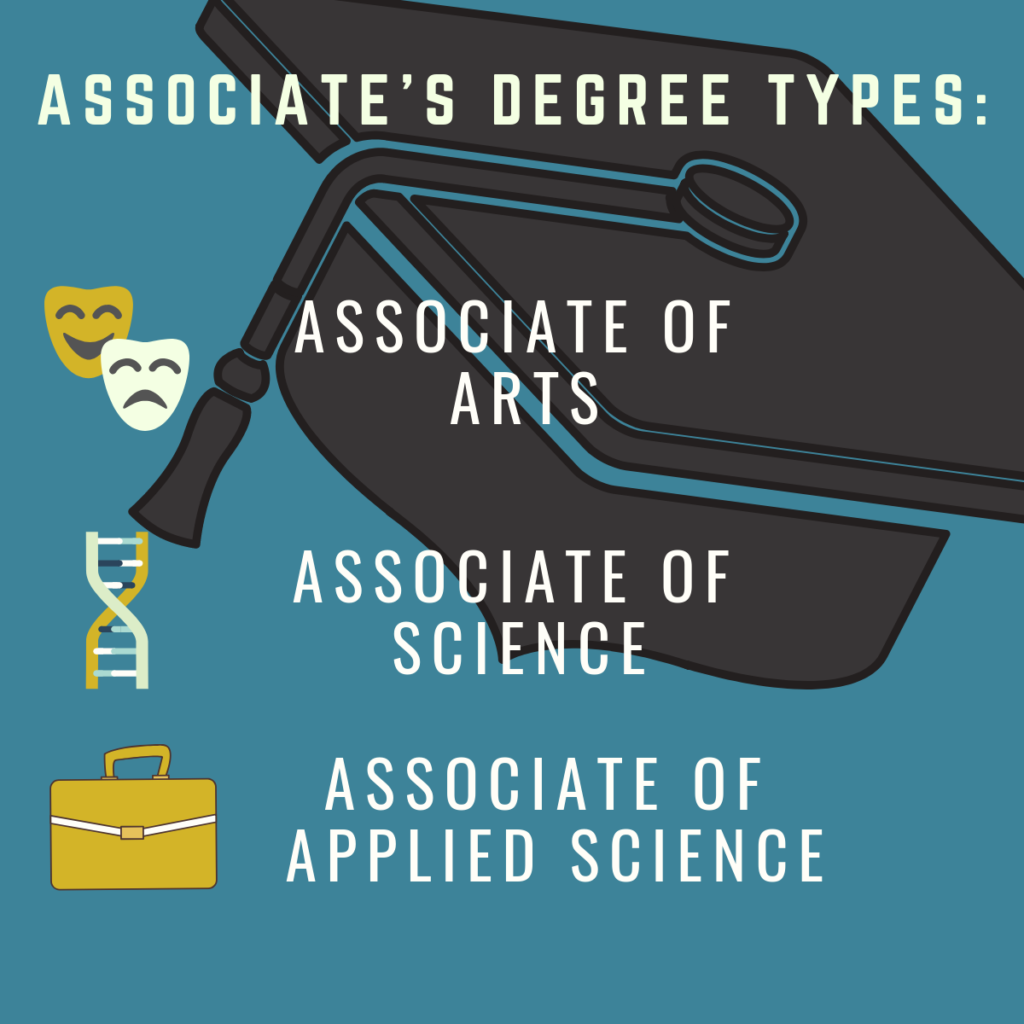
Associate of Arts (A.A.) Degrees
This type of associate’s degree is most common for majors in the humanities, arts, and social sciences. Examples of AA majors include:
- General Studies
- Psychology
- Graphic Design
- English
People usually pursue an Associate of Arts with the aim of going on to earn a bachelor’s degree in the same major at a four-year college. About 45 of the 60 credits typically required for graduation will be in liberal arts classes, which make up a large proportion of a bachelor’s degree curriculum.
Associate of Science (A.S.) Degrees
This type of associate’s degree is most common for majors in STEM (Science, technology, engineering, and mathematics) subjects. Examples of AS majors include:
- Nursing
- Criminal Justice
- Business Administration
- Computer Science
Some people choose an AS degree with the aim of going on to earn a bachelor’s degree in the same STEM subject. But an AS is enough qualification to gain entry level employment in many technical fields, such as Medical Records Technology, Administrative Assistance, and Nursing.
Associate of Applied Science (A.A.S.) Degrees
This type of associate’s degree is most commonly found in vocational majors. Examples of AS majors include:
- Web Design
- Paralegal Studies
- Dental Hygiene
- Veterinary Technology
Unlike an A.A. or A.S. degree, this type of associate’s degree is not designed for students who wish to continue their studies at some point in a four-year college. Instead, an A.A.S. is specifically aimed at providing students with job-ready skills so they can enter a specific profession upon graduation. A.A.S. programs tend to be hands-on and provide the particular up-to-date technical skills that industries are looking for.
How Long Does it Take to Earn an Associate’s Degree?
Traditionally, an associate’s degree takes two years to earn on a full-time basis. In fact, it’s sometimes referred to as a two-year degree. But many students take three years or longer to earn theirs, based on their pace of classes. Some students are enrolled part-time, and some pause their studies if life events (such as maternity leave or increased work duties) prevent them from enrolling, and then pick up their classes later on. Alternating between full-time and part-time enrollment is also common, and is even associated with better outcomes. A recent study found that adult students returning to school were more likely to complete their associate’s degree if they switched between full-time and part-time classes, possibly because this flexible approach allowed them to stay in school without stopping altogether.
On the other hand, one of the appealing things about an associate’s degree is how quickly it can get a student into the workforce with a relevant degree. Some schools help students quickly launch their careers, or jump-start their path to a bachelor’s, with an accelerated associate’s degree. An accelerated associate’s program takes less than two years, and usually has a heavier course load condensed into a shorter time span, sometimes as little as 18 months.
Learn more about how long it takes to get an associate degree.
More Info:
24 Fastest Online Associate’s Degrees
Where Can I Earn an Associate’s Degree?
Associates’ degrees are awarded at community colleges, vocational schools, technical colleges, and at some colleges and universities. Community colleges are junior colleges serve regional areas and are at least partially supported by local government funds. Because they serve local populations, community colleges are non-residential, so students can commute to school and live off-campus, which typically saves money. Many schools that award associate’s degrees hold articulation agreements with four-year schools. Under these formal arrangements, students can seamlessly transfer their credits towards a bachelor’s degree in the same major, without having to go through a complex process involving transcripts and proving course equivalencies.

Many students also choose to earn an associate’s degree online. This option is increasingly popular, especially with the growing number of “non-traditional students.” In the past, most students entered college right after graduating high school, and took classes full time. But the data shows that today’s college students are much different: 40% are 25 or older, 51% are employed, and 15% are even single parents. It’s no surprise that as much as 37% take classes part-time, and most want the most flexible, convenient format possible. Online class content and assignments can usually be accessed on-demand, from home or even a mobile devise, making them ideal for students who are busy working adults. In fact, the BLS found that more students enrolled in online classes were pursuing associate’s degrees than any other degree level.
More Info:
An associate’s degree awarded online from an accredited school can carry the same weight as one from a brick-and-mortar school. And, like brick-and-mortar colleges, many online schools also hold articulation agreements with four-year institutions, so you can smoothly transfer the credits from an associate’s degree towards a bachelor’s at a participating school.
Wherever you choose to study, make sure your school is accredited. Accreditation is simply a vetting process that can be conducted at the regional or national level, in which an independent organization assesses a school’s teaching, curriculum, class sizes and other measures against a set of quality standards. Schools that are accredited have gone through a rigorous process to prove their quality, and an associate’s degree from an accredited school carries much more weight with employers than one from a non-accredited institution.
How Much Does Earning an Associate’s Degree Cost?
As the shortest college degree, an associate’s is naturally the most inexpensive degree level you can earn. The actual costs of earning an associate’s degree vary widely based on your chosen school. A large proportion of students working towards an associate’s degree are enrolled in community colleges. According to the National Center for Education Statistics, the total cost (including tuition, books, room and board, fees etc.) for two-year institutions came to an average of $10,432 per year. At public 2-year schools, the average cost was $9,939, and at private schools the cost was as high as $24,367. Location matters, too. Attending a local community college is an extremely popular for associate’s degree seekers who want to save money. In-state tuition at a community college costs around $5,500, with another $1,500 expected for commuting, books, and fees. If you’re planning to go on to pursue a bachelor’s, your community college likely holds an articulation agreement with a state school, where you can also take advantage of much cheaper in-state tuition as well.
Some online schools also cost less than the national average, as they have less overhead, and may save you the cost of books and materials if they offer free e-textbooks. Another potentially cost-saving measure found in some online associate’s degrees is flat-rate tuition. In this model, students pay a set.tuition per semester regardless of how many classes they take, and complete them at their own pace. Those who work at an accelerated pace can finish faster and save money overall by completing more classes in less time.
What are Stackable Credentials?
Many students choose to earn an associate’s degree as a stepping stone towards a bachelor’s degree. This approach has several advantages. It allows them to use their associate’s degree to land a better job while pursuing a bachelor’s part-time, to transfer from a cheaper 2-year school to a 4-year school, or to clinch a lower degree and then go back to school for a higher degree at a later time (say, after their children are in school).
The same approach, and advantages, can be seen in an associate’s degree program that is designed with Stackable Credentials. In the stackable credentials model, students first earn a technical diploma or certificate as part of their path towards an associate’s degree. Students get the benefit of quickly earning a valuable credential, which can deliver workplace value and give them momentum to continue in their program. In fact, a controlled study of an associate’s degree program with stackable credentials found that students in an A.A.S. program were more likely to complete their associate’s degree if they earned an embedded technical diploma along the way.
Can Prior Credits be Applied Towards an Associate’s Degree
If you have earned some college credits but do not hold a degree, you are not alone. In 2000, the Census Bureau found that a full 14% of Americans have one or more years of college, though they do not hold a degree. Another 7% have taken college courses, but have less than 1 year under their belts. Most Americans surveyed by Forbes cited “cost” as the reason that people leave school before earning their degrees. Other common reasons include work and family demands.
The BLS’s 2013 survey of jobs found that those requiring “some college but no degree” paid an average salary of $29,100. Compare that to an average of $58,240 for jobs requiring an associate’s degree, and it’s clear that turning “college experience” and “college degree” makes a big difference. Fortunately, many students return to college to complete their degrees, and schools are well equipped to help them do so.
If you’re considering returning to school to complete your associate’s degree, research your prospective school’s transfer policy. You’ll want to be sure that the credits you invested time and money to earn will be accepted at your new school, and will meet the class requirements for your major. Don’t assume that a prospective college will count your transfer credits just because a class at one school has the same title as a class at another. If you’re returning to the same school where you started your degree in the first place, find out if the associate’s degree requirements are still the same. Colleges often change the classes required for their majors, or add prerequisites. This is especially true of technical programs, where the skills taught must be very up-to-date in order to meet current professional standards.
How Much Can I Earn with an Associate’s Degree?
In 2013, the BLS survey found that the median salary for jobs requiring an associate’s degree was $58,240. Over the course of a 40-year career, that adds up to $2,329,600. With a job requiring just a high school diploma, you can expect to earn considerably less, about $35,580 per year. Over the course of a 40-year career, you’d be looking at $1,423,200.
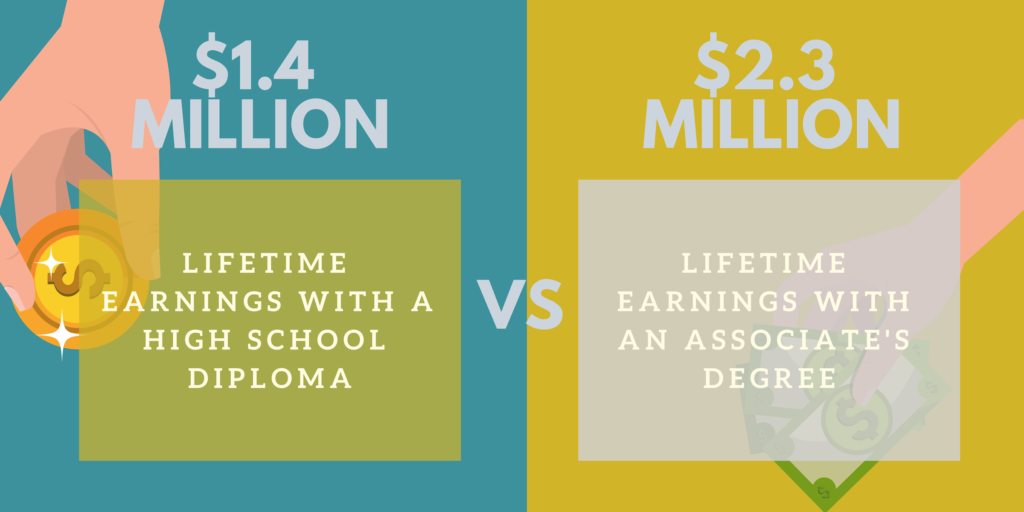
That figure doesn’t tell the whole story, of course. Many people who earn an associate’s degree go on to earn a bachelor’s degree, which leads to a median annual salary of $68,190, according to the BLS’s 2013 survey. If an associate’s degree serves as your stepping stone to a bachelor’s degree, its value becomes a part of that higher earning potential.
Another piece of the picture is your field of study. Associate’s degree majors with the highest return on investment tend to be in high-growth technical fields, like healthcare, energy, and IT. In jobs like this, having an up-to-date skill set that’s relevant to employer’s needs is everything. Jobs like these often require additional on-the-job training, and you may want to pursue additional certifications down the line to increase your marketability.
Based on data from the BLS, the highest-paying jobs with an associate’s degree are Air traffic controller (with a salary of $108,040), General/operations manager (with a salary of $94,400), and Construction manager (with a salary of $83,860). Healthcare positions are also high-paying options with an associate’s degree- 6 of the 10 highest-paid jobs with an associate’s degree are in the field of healthcare.
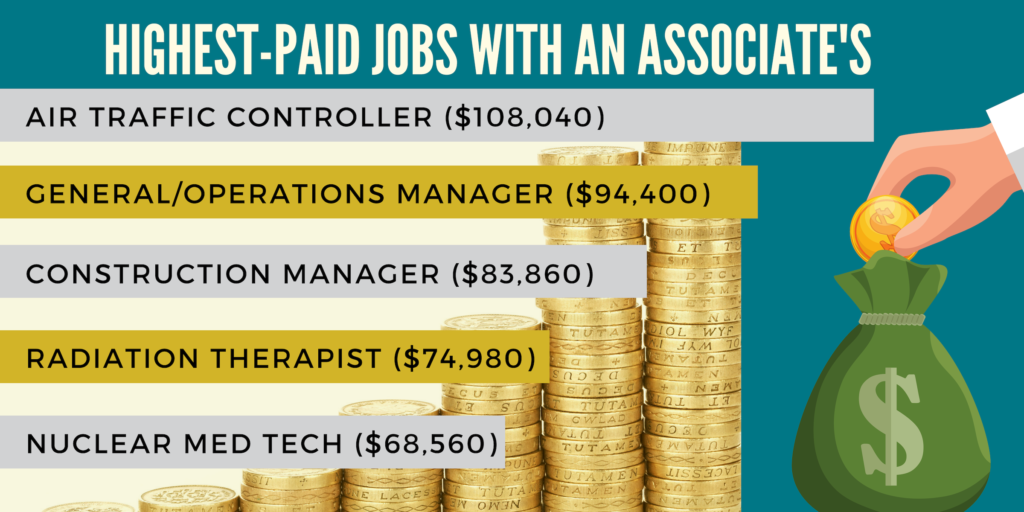
Learn more about the top 10 highest-paying jobs with an associate’s degree.
What is the Career Outlook with an Associate’s Degree?
A 2013 survey by the BLS found that 4.3% of jobs in America required an associate’s degree, for a total of 5,719,860 positions. The states with the highest proportion of jobs with an associate’s as a requirement were Massachusetts, Vermont, South Dakota, and West Virginia. Unemployment rates for those with an associate’s degree are lower than the national average, as well- 3.8% as opposed to 4.3%.

The fastest growing jobs today involve tech and the healthcare sector. That’s great news for those with an associate’s degree, especially those who graduated from a program with an occupational focus. Many of the fastest-growing jobs within these fields require the type of technical expertise and hands-on skills that are taught in an occupation focused associate’s degree program. The type of critical thinking and broad liberal arts approach of a traditional bachelor’s degree simply isn’t necessary in this type of field. Jobs like phlebotomist, turbine service technician, and X-ray technician are high-growth, high-paying and respected positions, and can be attained with an associate’s degree.
The BLS reports that some of the fastest-growing positions for those with an associate’s degree are Diagnostic Medical Sonographer, (with a growth rate of 17%), paralegal (with a growth rate of 15%), and radiation therapists, (with a growth rate of 13%). All of these high-growth jobs pay high salaries, as employers want to attract and retain qualified staff in these fast-growing roles.
Further Reading:
- 25 Fastest Online Associate’s Degrees
- 50 Highest Paying Associate Degree Jobs
- Easiest Online Associate’s Degrees
- 50 Best Online Associate’s Degrees 2018
- 15 Affordable Degrees in Dental Hygiene (Associate’s and Beyond)
- Which degree is better: AA or AS?
- What Is the Benefit of a BSN Degree Vs an ADN Degree?
- What Is the Benefit of a Bachelor’s in Accounting Degree Vs an Associate’s in Accounting Degree?
- What Is the Benefit of a Bachelor’s in Accounting Degree Vs an Associate’s in Accounting Degree?
- What Kind of Job Can You Get With an Associate’s Degree in Accounting?
- What Are the Highest-Paying Jobs With an Associates Degree in Accounting?
- What Are the Highest-Paying Business Entry-Level Jobs?
- What is the Minimum Degree to be a Counselor?
- What is the Benefit of having a Degree in Web Design?

